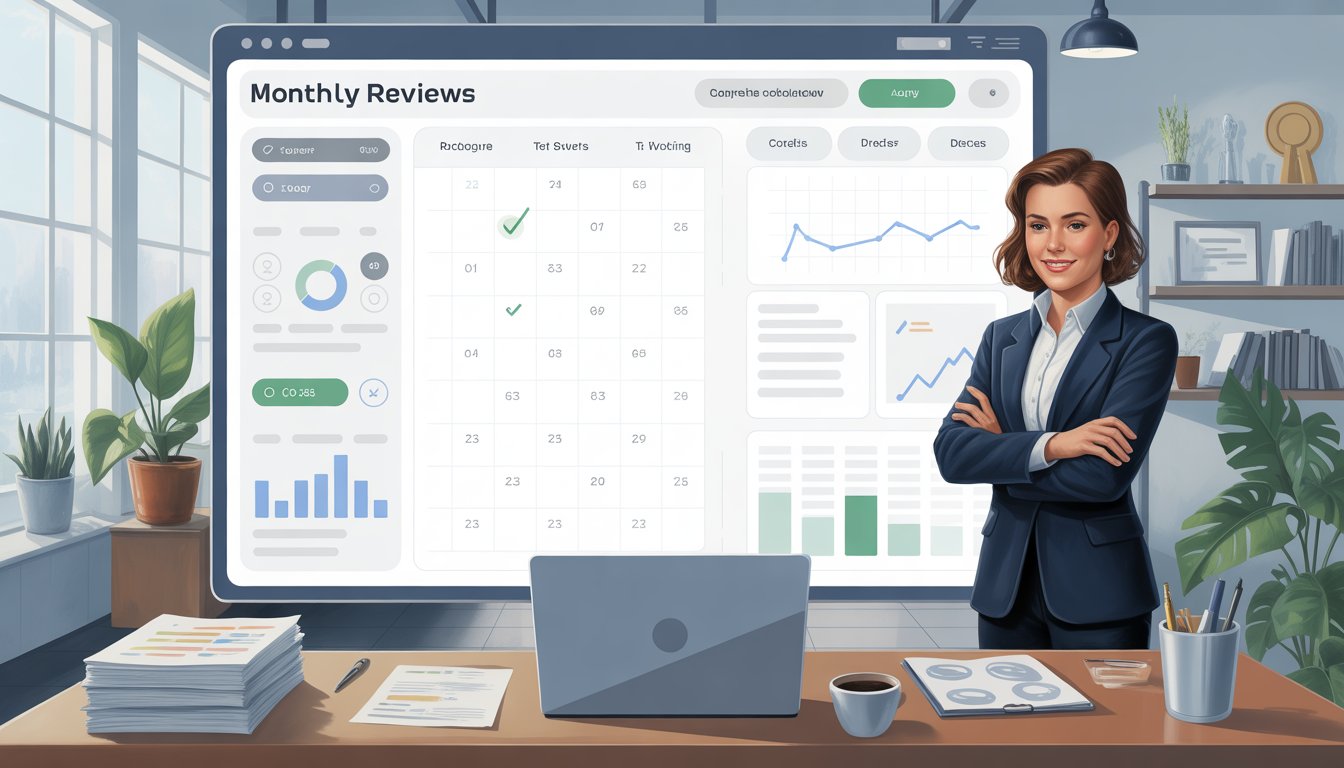Getting more Google reviews each month is crucial for your business success. Many business owners wonder exactly how many they should target.
The answer depends on your goals, industry, and current review count. There are clear guidelines to follow.

Most businesses should aim for 10-15 new Google reviews per month to maintain steady growth and a strong online presence. This range gives you enough fresh content to show Google that customers actively engage with your business.
It also helps build trust with potential customers who read your reviews before making decisions. Your monthly review goals should also consider your competition and business type.
If your competitors have hundreds of reviews, you may need to aim higher than 15 per month to catch up. Small local businesses can start with 5-10 reviews monthly.
Restaurants and service businesses often need 15-20 new reviews each month to stay competitive.
Key Takeaways
- Aim for 10-15 new Google reviews per month for steady growth and improved online visibility
- Adjust your monthly goals based on what your competitors have and your business type
- Focus on getting consistent reviews over time rather than large bursts of reviews all at once
Understanding the Importance of Monthly Reviews

Monthly reviews serve as a foundation for maintaining your online presence and business growth. They directly influence how customers perceive your business and affect your visibility in search results.
Impact on Online Reputation
Your online reputation shapes how potential customers view your business before they ever walk through your door. Google reviews and other online feedback create a digital first impression that can make or break a sale.
A consistent flow of monthly reviews helps dilute the impact of negative feedback. When you receive one bad review among ten positive ones, it carries less weight than one bad review among only two total reviews.
Fresh reviews signal to customers that your business is active and currently serving people. Reviews from three months ago tell a different story than reviews from last week.
Monthly review benefits for reputation:
- Reduces impact of negative reviews
- Shows current business activity
- Provides recent customer experiences
- Demonstrates consistent service quality
Role in Local Search Results
Google uses review frequency and recency as ranking factors for local search results. Businesses that regularly receive reviews often rank higher than competitors with older or fewer reviews.
Your review velocity matters more than total review count for local search. A business with 50 reviews in the past year will typically outrank one with 100 reviews spread over five years.
Location-based searches heavily favor businesses with recent review activity. When someone searches "restaurant near me," Google prioritizes businesses with fresh customer feedback.
Key local search factors:
- Review recency (how new reviews are)
- Review frequency (how often you get them)
- Total review volume
- Review response rates
Building Trust with Potential Customers
New customers rely on recent reviews to gauge current service quality. They want to know what your business is like today, not what it was like two years ago.
A steady stream of monthly reviews creates social proof that builds confidence. When customers see that others regularly choose your business, they feel more comfortable making the same choice.
Response rates to reviews also build trust. When potential customers see you actively engage with feedback, they know you care about customer experience.
Trust-building elements:
- Recent customer experiences
- Consistent positive feedback
- Active owner responses
- Detailed review content
Fresh reviews help customers understand what to expect. Detailed monthly feedback gives prospects insight into your current offerings, staff, and service levels.
How Many Reviews Should I Aim for Each Month?

Most businesses should target 10-15 new reviews per month for steady growth. Your specific goal depends on your industry competition and customer base size.
Recommended Monthly Review Targets
Small businesses should aim for 10-15 reviews per month. This builds trust without overwhelming your review collection process.
Medium businesses with higher customer volume can target 20-30 reviews monthly. This pace helps you stay competitive in busier markets.
Large businesses or those in competitive industries may need 30+ reviews per month. Fast-growing review counts signal active customer engagement to potential buyers.
Daily breakdown: Target 1-2 reviews per day for most businesses. This creates consistent growth without appearing artificial to customers or search engines.
Start with lower targets if you're new to review collection. You can increase your monthly goals as your review strategy improves and customer participation grows.
Industry Benchmarks and Variations
Restaurants and retail need higher review counts due to frequent customer visits. Aim for 25-40 reviews monthly in these sectors.
Professional services like law firms or accounting can succeed with 5-10 reviews per month. Customers use these services less often but rely heavily on reviews.
Hotels and hospitality should target 30-50 reviews monthly during peak seasons. Travel customers expect to see recent, frequent feedback.
Healthcare and dental practices work well with 8-15 reviews per month. Patients value quality over quantity in medical reviews.
Local businesses face different competition levels. Check your competitors' monthly review counts and aim for similar numbers to stay competitive.
Factors Influencing Your Monthly Review Goal
Customer volume directly impacts realistic targets. Businesses serving 100 customers monthly can't expect 50 reviews without strong review requests.
Industry competition affects your needs. Crowded markets require more reviews to stand out from similar businesses.
Current review count influences monthly goals. Businesses with under 20 total reviews should prioritize getting to 30+ before focusing on monthly targets.
Review request systems determine success rates. Automated email follow-ups typically generate 5-15% response rates from customers.
Seasonal patterns change monthly needs. Retail businesses may need 3x more reviews during holiday seasons compared to slow months.
Your business age matters too. New businesses should focus on reaching 20-30 total reviews quickly, while established businesses can maintain steady monthly growth.
Consistency vs. Quantity: Striking the Right Balance
Getting reviews steadily over time builds more trust than collecting many reviews all at once. A steady flow of feedback shows customers that your business stays active and cares about service quality.
The Value of Steady Review Growth
Consistent review flow strengthens your online presence more than large batches of reviews. Google's algorithm favors businesses that get fresh feedback regularly.
A steady stream of 3-5 reviews per month looks more natural than 20 reviews in one week followed by silence. This pattern signals to both customers and search engines that your business operates consistently.
Recent reviews matter more than old ones. Over 66% of customers ignore reviews older than 90 days.
Steady growth also helps with review management. You can respond to each review thoughtfully instead of feeling overwhelmed by sudden influxes.
Search engines reward consistency with better local rankings. Regular reviews keep your business visible in search results and help you compete with other local businesses.
Risks of Sudden Review Spikes
Large spikes in reviews can trigger suspicion from both customers and platforms. Getting 50 reviews in one day after months of no activity looks unnatural.
Google may flag your business for fake reviews if you see sudden increases. This can hurt your search rankings or even result in review removal.
Customers notice when review timing seems off. They trust businesses with steady feedback more than those with sporadic bursts.
Managing many reviews at once becomes difficult. You might miss responding to negative feedback quickly or give generic responses that don't address specific concerns.
Sudden spikes also create unrealistic expectations. If you get 30 reviews this month but only 2 next month, the drop-off looks concerning to potential customers browsing your profile.
Setting Goals Based on Competition
Looking at your competitors helps you set realistic review targets that give you an edge in local search results. Your monthly review goals should reflect what top-performing local businesses in your area are achieving.
Analyzing Competitor Review Counts
Start by researching the top 5-10 local businesses in your industry. Check their Google Business profiles, Yelp pages, and other review platforms.
Look at these key factors:
- Total review counts across all platforms
- Monthly review growth over the past 6-12 months
- Review response rates and engagement levels
- Average star ratings compared to review volume
Create a simple tracking table with competitor names, total reviews, and estimated monthly gains. Most successful local businesses earn 10-25 new reviews per month.
Pay attention to seasonal patterns. Restaurants might see more reviews during holidays. Service businesses often get more reviews after busy seasons.
Don't just count reviews. Notice which competitors respond to reviews quickly and professionally.
Adjusting Targets for Competitive Advantage
Set your monthly review target at 20-30% higher than your top competitor's average monthly gain. If they earn 15 reviews monthly, aim for 18-20.
For new businesses, start with smaller targets:
- Months 1-3: 5-8 reviews per month
- Months 4-6: 8-12 reviews per month
- Months 7+: Match or exceed competitor rates
Focus on consistency over big jumps. Getting 10 reviews every month beats getting 30 one month and zero the next.
Consider your business size and customer volume. A busy restaurant can realistically aim higher than a specialized service provider.
Track your progress weekly. If you're falling behind, adjust your review request strategy or timing.
The Quality of Reviews Matters
Getting many reviews each month is important, but the quality of those reviews affects your business success just as much. Quality reviews build trust with customers and help your business rank better in search results.
Encouraging Detailed, Positive Feedback
Detailed reviews carry more weight than short ones. They provide specific information about your products or services that helps other customers make decisions.
Ask customers to mention specific details in their reviews. You can request they talk about:
- Product features they liked most
- Service quality they experienced
- Staff members who helped them
- Problems solved by your business
Send follow-up messages 24-48 hours after purchase. This timing catches customers when their experience is still fresh in their minds.
Make the review process simple. Send direct links to your Google Business Profile or review platform.
Positive reviews boost your reputation and search rankings. They show potential customers that others trust your business.
Managing Negative Reviews Effectively
Negative reviews will happen to every business. How you handle them shows your professionalism and can actually improve customer trust.
Respond quickly to negative reviews within 24-48 hours. This shows you care about customer concerns and are actively managing your business.
Follow this approach for negative review responses:
- Thank the reviewer for their feedback
- Apologize sincerely for their poor experience
- Offer a solution or way to make things right
- Take the conversation offline when appropriate
Never argue with reviewers or get defensive. Other customers read your responses and judge your business based on how you handle criticism.
Some negative reviews can actually help your credibility. A business with only perfect reviews might look fake to potential customers.
A mix of mostly positive with some negative reviews appears more authentic.
Detecting and Preventing Fake Reviews
Fake reviews hurt your business in multiple ways. They can trigger Google's spam filters and damage your reputation when discovered.
Watch for these warning signs of fake reviews:
Red FlagWhat to Look ForTimingMultiple reviews posted at the same timeLanguageIdentical wording or phrasesAccountsNew profiles with no other review historyLocationReviews from distant geographic areas
Avoid paying for fake reviews or asking friends and family to post reviews. Google's algorithms detect these patterns and may remove all suspicious reviews from your profile.
Focus on earning authentic reviews instead. Provide excellent service and ask real customers for honest feedback.
Train your staff to naturally request reviews during positive customer interactions. Report fake reviews about your business to the review platform.
Most sites have processes to investigate and remove reviews that violate their policies.
Maintaining and Improving Your Google Business Profile
Getting reviews is just the first step - you need to actively manage your Google Business Profile to keep it working for your business. Quick responses to customer feedback and smart use of multiple platforms can boost your local search rankings.
Responding to Reviews
You should respond to every review on your Google Business Profile within 24-48 hours. This shows potential customers that you care about feedback and stay engaged with your business.
For positive reviews, keep responses short and personal. Thank the customer by name when possible.
Mention specific details they shared about their experience. Thank them for their time and reference something specific they mentioned.
Invite them to return.
For negative reviews, stay calm and professional. Never argue or get defensive in your response.
Acknowledge their concern and apologize for any issues. Offer to discuss the matter privately and provide your contact information.
Leveraging Multiple Review Sites
Don't put all your focus on Google reviews alone. Customers use different review sites depending on your industry and location.
Key review platforms to consider:
- Yelp (especially for restaurants and retail)
- Facebook Business Page
- Industry-specific sites (like Angie's List for contractors)
- Better Business Bureau
Ask satisfied customers to leave reviews on the platforms where your competitors have the most activity. This helps you compete more effectively in your local market.
Make it easy for customers by sending direct links to your review profiles. You can include these links in follow-up emails or text messages after a purchase.
Track your ratings across all platforms monthly. This helps you spot patterns in customer feedback and address issues before they hurt your reputation.
Optimizing for Star Ratings and Visibility
Your star rating directly impacts both search visibility and customer decisions. A rating of 3.5 stars or higher is essential for maintaining Google's favor.
Ratings below this threshold can hurt your local search rankings.
Effective Strategies for Achieving a 5-Star Rating
Focus on making the review process simple for satisfied customers. Use QR codes on receipts or display them in your store for quick access to your Google Business Profile.
Send follow-up emails within 24-48 hours after service completion. This timing catches customers when their experience is still fresh in their minds.
Ask happy customers immediately after positive interactions rather than waiting days or weeks. Timing your requests matters more than the number you send.
Provide direct links to your review page in all communications. Remove friction by eliminating extra steps that might discourage customers from completing reviews.
Train your staff to naturally mention reviews during positive customer interactions. A simple "We'd love a review if you're happy with our service" works better than formal requests.
Understanding How Star Ratings Affect Customer Perception
Most customers won't consider businesses with ratings below 3.5 stars. Your google star rating acts as an instant credibility check before they read individual reviews.
A mix of ratings actually builds more trust than perfect 5-star ratings. Customers expect some variation in experiences and may view all perfect ratings as fake.
Star ratings appear in search results before customers click on your business listing. This makes your rating one of the first impressions potential customers form.
Customers typically scan your overall rating first, then read 2-3 recent reviews. Your 5-star rating needs to be supported by quality written feedback to convert browsers into customers.
Research shows the sweet spot for customer conversion happens between 20-50 total reviews with an average of 4.0+ stars. This combination provides both credibility and social proof.
Frequently Asked Questions
Business owners often wonder about the specific numbers needed to build credibility and improve ratings. The answers depend on your current rating, competition, and industry standards.
What number of positive reviews is necessary to significantly improve a low online rating?
You need different amounts of positive reviews based on your current situation. If you have fewer than 10 total reviews, just 1-2 new positive reviews can raise your score to the next level.
For businesses with low ratings that want major improvement, the numbers are higher. If your rating dropped from 5 stars to 4.2 stars, you need about 15 new good reviews to get back to 4.8 stars.
Businesses with around 50 reviews need 10 to 20 new positive reviews to increase their average by one decimal point. The more total reviews you have, the harder it becomes to change your average rating quickly.
Is there an ideal frequency for receiving reviews to maintain a credible rating?
You should aim for at least a few new reviews each month. This shows Google that your business stays active and relevant to customers.
Getting reviews consistently matters more than collecting a huge number all at once. Google values businesses that maintain ongoing customer engagement over time.
A steady stream of fresh reviews helps your search ranking and reputation.
How can obtaining more reviews impact my business's overall star rating?
More reviews can help or hurt your star rating depending on their quality. Each new review changes your average rating since Google calculates the total as a weighted average.
If you have 10 reviews with a 5-star average, one 1-star review drops your rating significantly to just above 4 stars. But if you have 100 reviews, one bad review has much less impact.
Higher review volume makes your rating more stable over time. Bad reviews hurt less when you have many good ones to balance them out.
What strategies can businesses employ to consistently receive reviews?
Ask customers directly after positive experiences while the interaction is still fresh in their minds. Train your staff to request reviews from happy customers during or right after service.
Send follow-up emails or texts to customers a few days after their purchase or visit. Include direct links to your Google Business Profile to make leaving reviews easy.
Encourage detailed reviews by asking customers to mention specific staff members, services, or products they liked. Detailed reviews carry more weight with potential customers than short generic ones.
How many reviews are typically considered sufficient for establishing business credibility?
Most businesses need about 10 Google reviews to start ranking in local searches. However, this number can vary based on your location, industry, and competition level.
Some businesses in less competitive areas might only need 5 reviews to start ranking. Others in crowded markets may need more than 10 to compete effectively.
Having 10-20 reviews gives you a solid baseline of credibility. You should aim to match or exceed what similar local businesses have to stay competitive.
What role does review volume play in influencing customer perception?
Customers often compare review counts when choosing between businesses.
If your competitors have 50 reviews and you have only 5, potential customers may pick them instead.
Customers actually prefer businesses with ratings between 4.2 and 4.7 stars over perfect 5-star ratings.
Perfect ratings can seem fake or too good to be true.
Review volume signals trustworthiness and shows that many people have tried your business.










